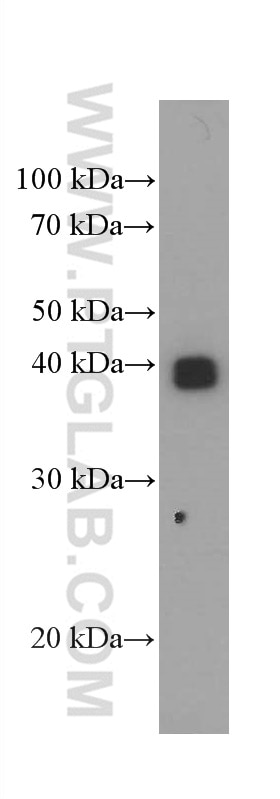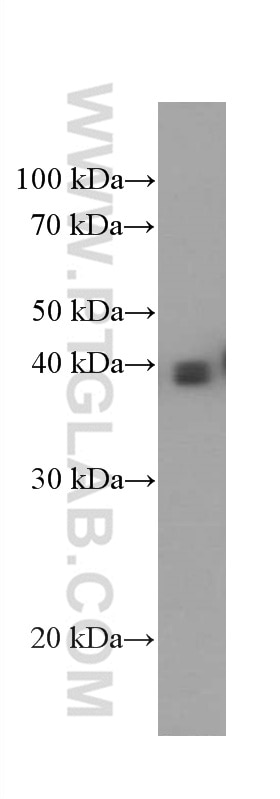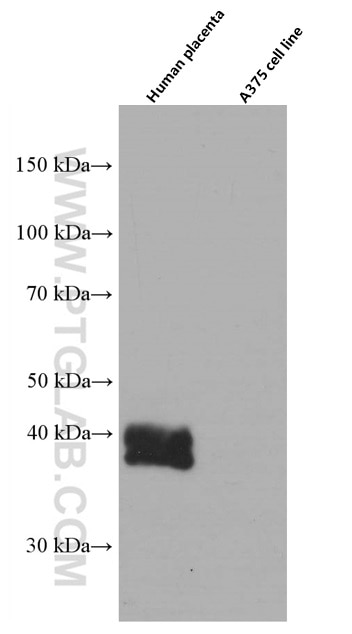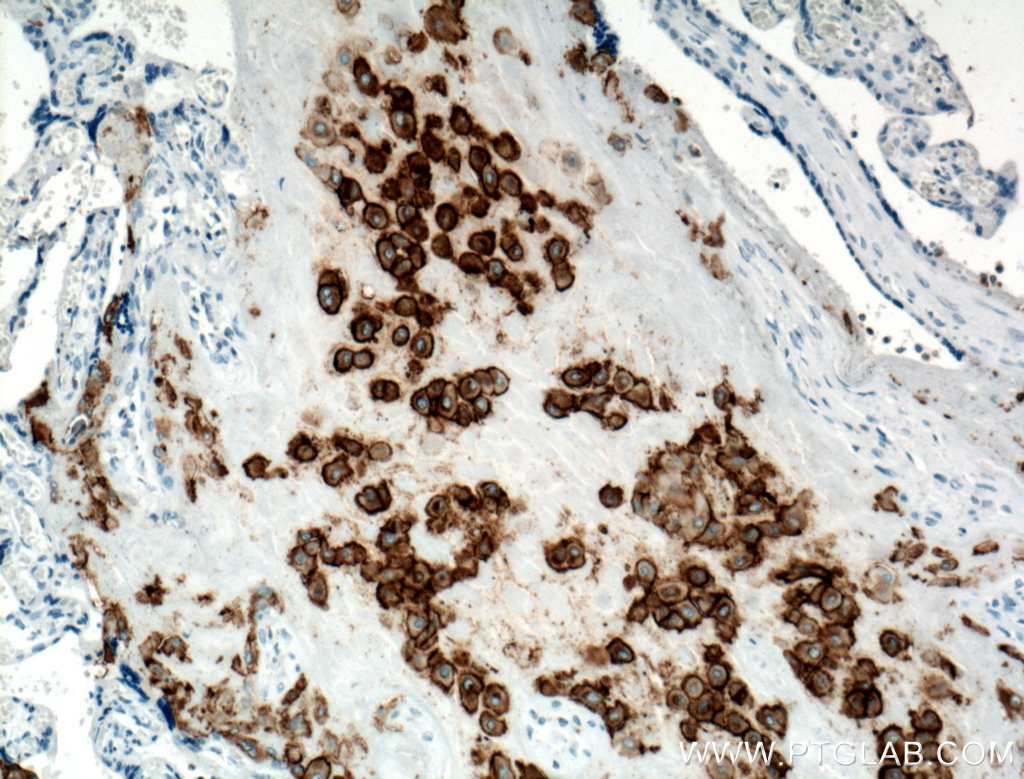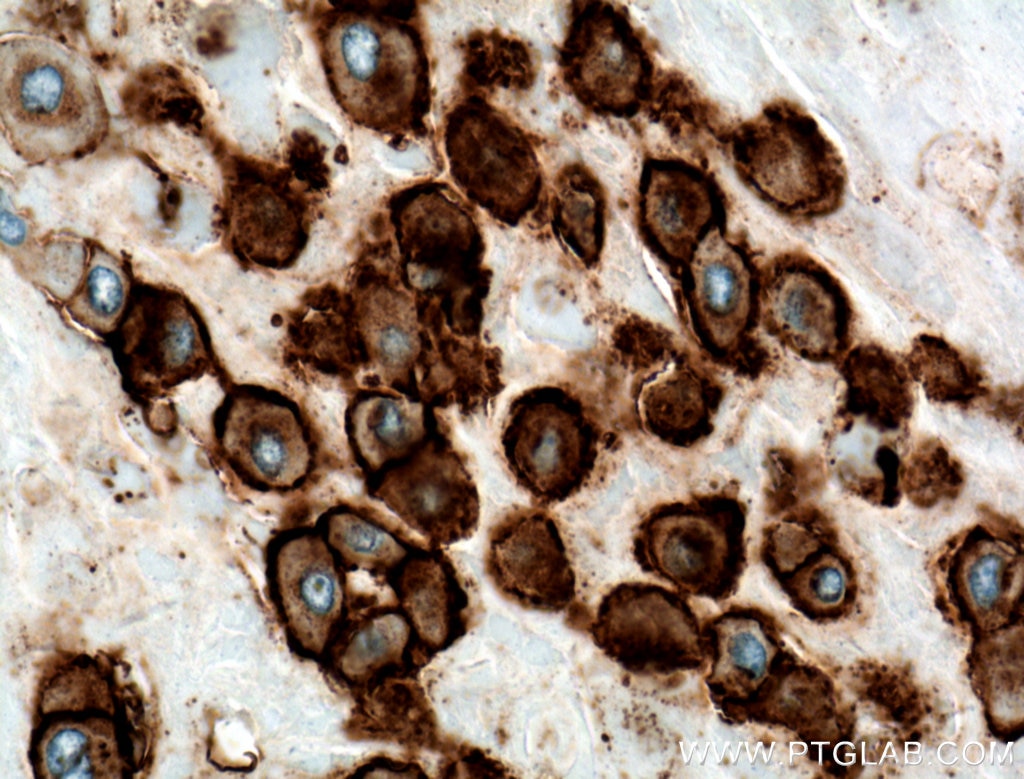Anticorps Monoclonal anti-HLA-G
HLA-G Monoclonal Antibody for WB, IHC, ELISA
Hôte / Isotype
Mouse / IgG2b
Réactivité testée
Humain
Applications
WB, IHC, IF, ELISA
Conjugaison
Non conjugué
CloneNo.
1E5A10
N° de cat : 66447-1-Ig
Synonymes
Galerie de données de validation
Applications testées
| Résultats positifs en WB | tissu placentaire humain |
| Résultats positifs en IHC | tissu placentaire humain il est suggéré de démasquer l'antigène avec un tampon de TE buffer pH 9.0; (*) À défaut, 'le démasquage de l'antigène peut être 'effectué avec un tampon citrate pH 6,0. |
Dilution recommandée
| Application | Dilution |
|---|---|
| Western Blot (WB) | WB : 1:2000-1:20000 |
| Immunohistochimie (IHC) | IHC : 1:50-1:500 |
| It is recommended that this reagent should be titrated in each testing system to obtain optimal results. | |
| Sample-dependent, check data in validation data gallery | |
Applications publiées
| WB | See 2 publications below |
| IHC | See 14 publications below |
| IF | See 21 publications below |
Informations sur le produit
66447-1-Ig cible HLA-G dans les applications de WB, IHC, IF, ELISA et montre une réactivité avec des échantillons Humain
| Réactivité | Humain |
| Réactivité citée | Humain |
| Hôte / Isotype | Mouse / IgG2b |
| Clonalité | Monoclonal |
| Type | Anticorps |
| Immunogène | HLA-G Protéine recombinante Ag10839 |
| Nom complet | major histocompatibility complex, class I, G |
| Masse moléculaire calculée | 338 aa, 38 kDa |
| Poids moléculaire observé | 33-45 kDa |
| Numéro d’acquisition GenBank | BC021708 |
| Symbole du gène | HLA-G |
| Identification du gène (NCBI) | 3135 |
| Conjugaison | Non conjugué |
| Forme | Liquide |
| Méthode de purification | Purification par protéine A |
| Tampon de stockage | PBS with 0.02% sodium azide and 50% glycerol |
| Conditions de stockage | Stocker à -20°C. Stable pendant un an après l'expédition. L'aliquotage n'est pas nécessaire pour le stockage à -20oC Les 20ul contiennent 0,1% de BSA. |
Informations générales
Human major histocompatibility complex (MHC) antigens, also referred to as human leukocyte antigens (HLA), are encoded by genes located on the short arm of chromosome 6 (6p21.3). HLA-G is a non-classical MHC class I molecule with multiple immunoregulatory properties. HLA-G exhibits a restricted pattern of expression that includes placental extravillous trophoblasts at the maternal-fetal interface, where it abolishes maternal immune cell activity against fetus and establishes immune tolerance. Aberrant expression of HLA-G has been found in a variety of human neoplastic diseases. It plays an important role in the escape of tumor cells from immunosurveillance.
Protocole
| Product Specific Protocols | |
|---|---|
| WB protocol for HLA-G antibody 66447-1-Ig | Download protocol |
| IHC protocol for HLA-G antibody 66447-1-Ig | Download protocol |
| Standard Protocols | |
|---|---|
| Click here to view our Standard Protocols |
Publications
| Species | Application | Title |
|---|---|---|
Aging Cell Advanced Maternal Age-associated SIRT1 Deficiency Compromises Trophoblast Epithelial-Mesenchymal Transition through an Increase in Vimentin Acetylation. | ||
Oxid Med Cell Longev Deletion of ACLY Disrupts Histone Acetylation and IL-10 Secretion in Trophoblasts, Which Inhibits M2 Polarization of Macrophages: A Possible Role in Recurrent Spontaneous Abortion. | ||
Mol Ther Nucleic Acids miR21 modulates the Hippo signaling pathway via interference with PP2A Bβ to inhibit trophoblast invasion and cause preeclampsia | ||
Biochim Biophys Acta Mol Cell Res Suppression of GATA3 promotes epithelial-mesenchymal transition and simultaneous cellular senescence in human extravillous trophoblasts | ||
FASEB J Cyclin G2 upregulation impairs migration, invasion, and network formation through RNF123/Dvl2/JNK signaling in the trophoblast cell line HTR8/SVneo, a possible role in preeclampsia. | ||
Cell Signal Hypermethylation and low expression of FOXM1 predisposes women to unexplained recurrent miscarriage by impairing trophoblast stem cell proliferation |
